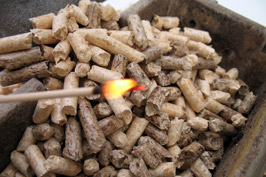Gas and oil are the most used heating fuels in our regions. However, other systems exist such as those that use renewable energy (heat pumps, solar panels, pellets) or even micro-cogeneration.
Different techniques:
• Renewable energies
• Micro-cogeneration
• Make-up heating
Heating with renewable energies
Today, there are plenty of alternatives: heat pumps, solar panels, pellet heating systems, etc. While they are indeed environment friendly, they can also be a (very) profitable investment. However, presently they represent a small percentage of the total energy consumption in Belgium.
Heat pumps

A heat pump is a system capable of transferring calories from an outside environment to inside for heating it.
There are different types of heat pump. They are classified according to the nature of the source wherefrom the energy is captured (air or land) and the source whereto the energy is restored (air or water).
When a heat pump uses ground as energy source to generate heat in a building, it is said to be "geothermal". The high-capacity of heat pumps is remarkable. For a kilowatt-hour of electricity consumed, they produce three to four times more energy.
Want to know more? Go to the Heat pumps section in the FAQ Heating.
The solar panels
Placed on rooftops or on any other flat surface at a height, solar panels capture some of the energy from sunlight. There are two types of panels:
• thermal solar panels and
• photovoltaic panels.
The thermal solar panels convert solar energy into thermal energy. This heat is sent to the boiler that heats the water of the house.
Photovoltaic solar panels convert solar energy into electrical energy. This electricity can be used to heat water or the house, as well as to produce cooling for air conditioning.
Do you have limited roof area or have the photovoltaic solar panels been placed on the shady side? Thermal solar panels can capture up to 80% of solar energy whereas photovoltaic solar panels have a standard yield of 15%.
Note in case of thermal panels:
• They produce less in the winter since heating demand is higher at this time.
• They must be installed with a hot water tank of adequate capacity to compensate for cloudy days in an optimal manner. Ask your fitter for more information.
Questions? Go to the Solar energy heating section in the FAQ Heating.
Heating with pellets

Pellets (small compressed granules of wood) are used as fuel for stoves and also for central heating. In case of central heating, it is necessary that the heating system is suited to this fuel.
These granules are made of compressed sawdust that is first ground and dried. The product has no binders or chemical additives. For information, the heat energy from two kilograms of pellets equals to that from one litre of oil.
Pellets emit CO2 captured in the past by timber, the balance is therefore considered as neutral. Compared to oil and gas, one cubic meter of pellets prevents the emission of around 850 kg of CO2 for oil and 580 kg of CO2 for gas.
Pellet is a heating solution that is especially suited to the urban environment. In fact, irrespective of whether it is used in a stove or through a central heating system, it produces very little ash by burning and requires less storage space than an oil tank.
However, one must ensure that the hot water tank has sufficient capacity to prevent the burner from starting up too often or from staying too long on the pilot burner which can cause emissions of fine particles (PM) and carbon monoxide (CO). A 20-litre tank times the capacity in KW is recommended. Thus, for a 15KW burner, one must provide a hot water tank of 20 x 15 = 300 litres.
Questions? Go to the Heating with wood section in the FAQ Heating.
Keeping warm while producing one's own electricity: micro-cogeneration
As the name suggests, the principle behind the micro-cogeneration system is cogeneration, i.e. the simultaneous production of two different energies (heat and electricity) in a single process from a single energy source (fuel).
It comprises a heat engine coupled to a generator. The heat dissipated by the engine is recovered by the exchangers and it feeds the heating circuit. Used since long in some large buildings (hospitals, hotels, etc.), this technique now also exists in the form of micro-cogeneration units of very low power (5-10 kW) compatible with domestic use. This technique, used with a biofuel, is especially suitable for reducing our footprint on the environment.
Auxiliary heating: electric heating and stove
Electric heating
Electric heating is inexpensive to install and deemed to be effective. However, it consumes a lot of electricity and the production and distribution of electricity results in high losses (up to 60%). In addition, it pollutes indirectly (on the whole, the electricity sector is polluting in nature). It is better to restrict electric heating to exceptional situations, such as auxiliary heating in a bathroom. It is not suitable for areas that are generally occupied.
Stove
In recent years, the stove has found some legitimacy with these new clean fuels that are replacing coal: wood briquettes or pellets. While purchasing, you must pay attention to energy efficiency as well as to the fine particulate matter (PM) emissions by the stove. It is also important to select a model that one may use properly and that will be installed correctly (depending on the proportion of fuel and proper ventilation). If you smother the fire too much and let it smoulder, you have more soot, particulate matter (PM) and carbon monoxide (CO). Ask your fitter for more information.
If you have questions about these fuels go to the Heating with wood section in the FAQ Heating and the Certified timber section.






